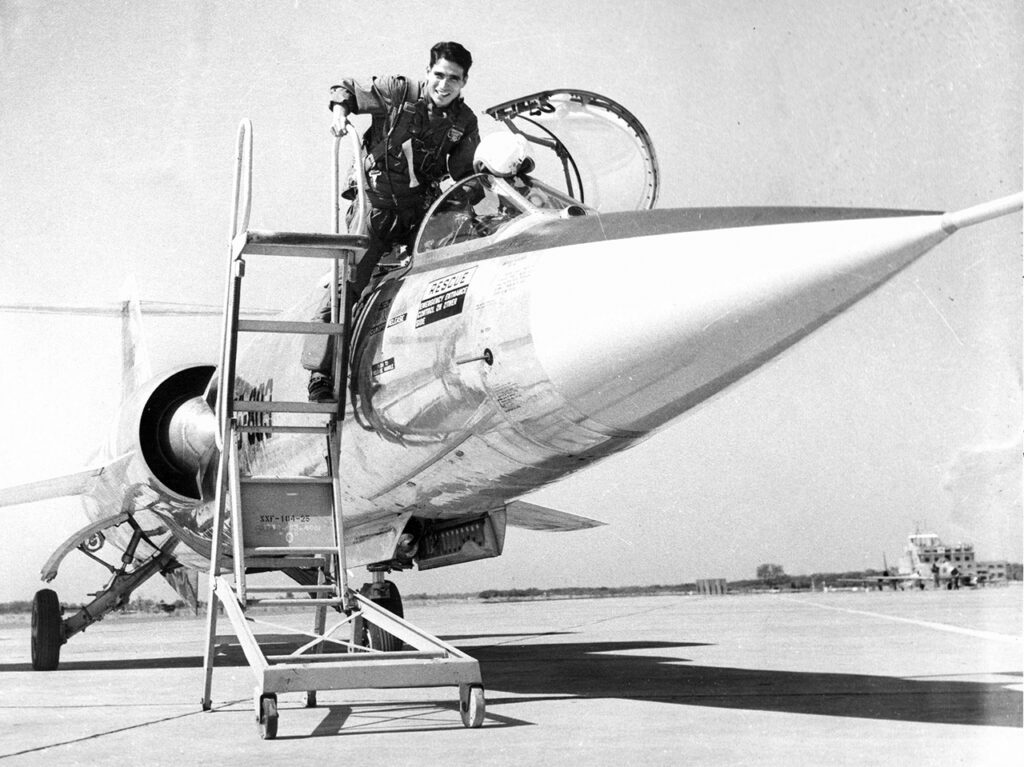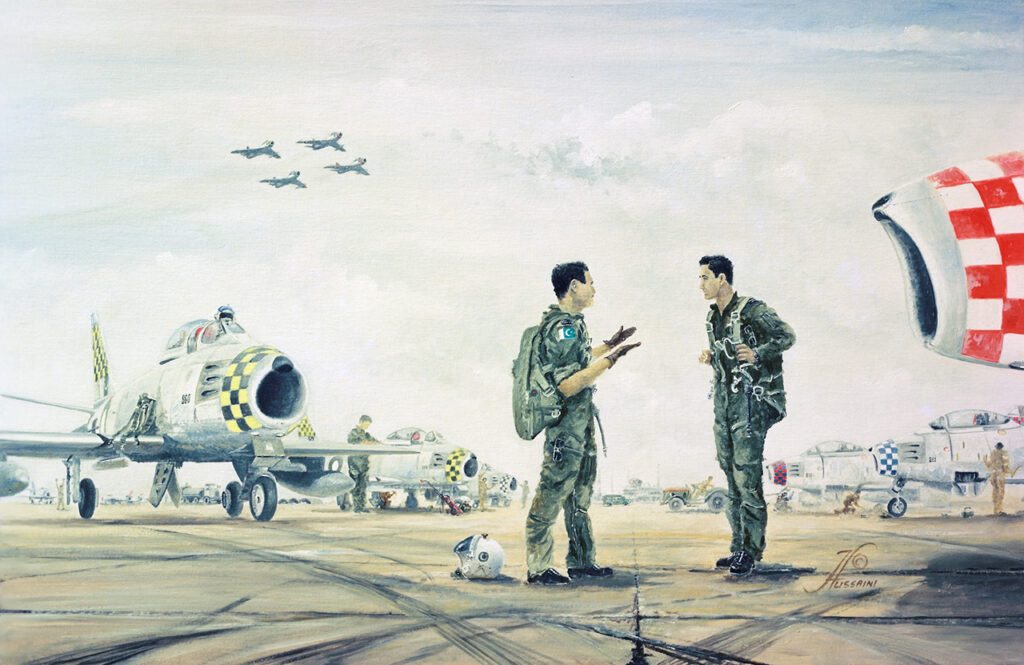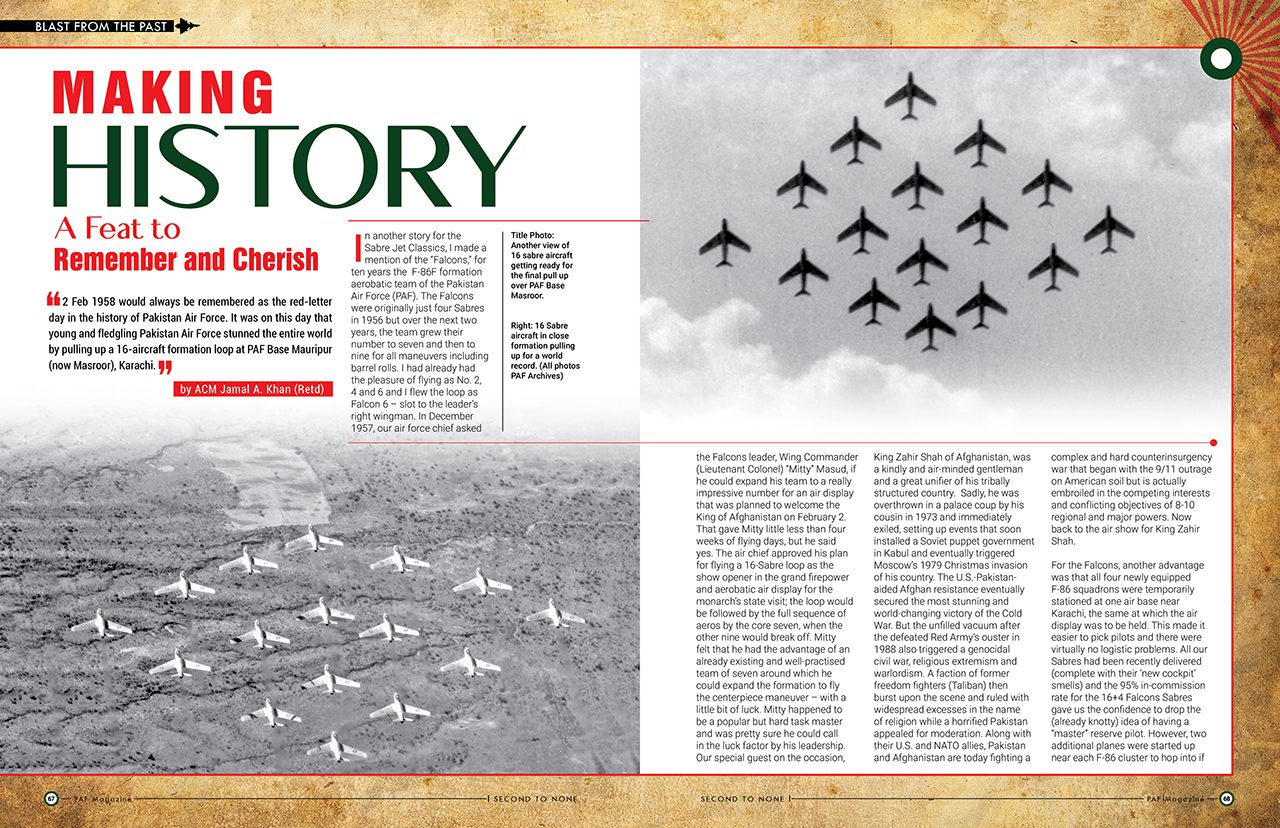A Feat to Remember and Cherish
2 Feb 1958 would always be remembered as the red-letter day in the history of Pakistan Air Force. It was on this day that young and fledgling Pakistan Air Force stunned the entire world by pulling up a 16-aircraft formation loop at PAF Base Mauripur (now Masroor), Karachi.
In another story for the Sabre Jet Classics, I made a mention of the “Falcons,” for ten years the F-86F formation aerobatic team of the Pakistan Air Force (PAF). The Falcons were originally just four Sabres in 1956 but over the next two years, the team grew their number to seven and then to nine for all maneuvers including barrel rolls. I had already had the pleasure of flying as No. 2, 4 and 6 and I flew the loop as Falcon 6 – slot to the leader’s right wingman. In December 1957, our air force chief asked the Falcons leader, Wing Commander (Lieutenant Colonel) “Mitty” Masud, if he could expand his team to a really impressive number for an air display that was planned to welcome the King of Afghanistan on February 2. That gave Mitty little less than four weeks of flying days, but he said yes.
The air chief approved his plan for flying a 16-Sabre loop as the show opener in the grand firepower and aerobatic air display for the monarch’s state visit; the loop would be followed by the full sequence of aeros by the core seven, when the other nine would break off. Mitty felt that he had the advantage of an already existing and well-practised team of seven around which he could expand the formation to fly the centerpiece maneuver – with a little bit of luck. Mitty happened to be a popular but hard task master and was pretty sure he could call in the luck factor by his leadership. Our special guest on the occasion, King Zahir Shah of Afghanistan, was a kindly and air-minded gentleman and a great unifier of his tribally structured country. Sadly, he was overthrown in a palace coup by his cousin in 1973 and immediately exiled, setting up events that soon installed a Soviet puppet government in Kabul and eventually triggered Moscow’s 1979 Christmas invasion of his country.

The U.S.-Pakistan-aided Afghan resistance eventually secured the most stunning and world-changing victory of the Cold War. But the unfilled vacuum after the defeated Red Army’s ouster in 1988 also triggered a genocidal civil war, religious extremism and warlordism. A faction of former freedom fighters (Taliban) then burst upon the scene and ruled with widespread excesses in the name of religion while a horrified Pakistan appealed for moderation. Along with their U.S. and NATO allies, Pakistan and Afghanistan are today fighting a complex and hard counterinsurgency war that began with the 9/11 outrage on American soil but is actually embroiled in the competing interests and conflicting objectives of 8-10 regional and major powers. Now back to the air show for King Zahir Shah.
For the Falcons, another advantage was that all four newly equipped F-86 squadrons were temporarily stationed at one air base near Karachi, the same at which the air display was to be held. This made it easier to pick pilots and there were virtually no logistic problems. All our Sabres had been recently delivered (complete with their ‘new cockpit’ smells) and the 95% in-commission rate for the 16+4 Falcons Sabres gave us the confidence to drop the (already knotty) idea of having a “master” reserve pilot. However, two additional planes were started up near each F-86 cluster to hop into if needed by any of the team pilots having trouble with his Sabre. We started engines fifteen minutes before taxi time.
All sixteen aircrew were experienced fighter pilots but for half of them the F-86 was their first jet fighter. Their ranks and numbers ranged between Wing Commander/Lieutenant Colonel (1), Squadron Leader/Major (5) and Flight Lieutenant/Captain (10).
After a week of cluster practices in four to six F-86s by the newly inducted pilots in separate pieces of sky and after disciplining the original core of seven into rock-steady flying that could induce maximum stability within the larger formation, the sixteen flew together for the first time with just two weeks remaining for the air show date. The experience was awesome for some of the pilots, especially those who had never flown formation aerobatic maneuvers with other planes surrounding them in all directions. The wingmen at the right and left wingtips of the large diamond of sixteen had (besides enjoying the best view, and possibly because of it) to concentrate the most for keeping well tucked in. And to power the bigger arc he was required to fly behind all his team mates, Falcon 16, the rear-most slotman of the diamond, had routinely to use 98-99% rpm to the leader’s 91%. The Group Commander of our F-86 wing, himself a highly admired ultra-low level aerobatic pilot, frequently accompanied us in an RT-33, taking pictures with the nose camera for the debriefings and to provide us with some very useful tips and occasional growls.
An interesting problem arose when, during one of the practice loops, a 120-gallon tank departed one of the Sabres. Spewing fuel, it rolled along the slat of the owner F-86 and then was thankfully seen to disappear in a trajectory away from the formation. The subject pilot could easily control the asymmetry through the remainder of the loop and the pilot flying his wing did not have the time even to bounce around a little because it all happened so fast. Although our sortie times would thenceforth be cut down a lot, Mitty decided we would fly even the work-up sorties in the clean configuration till show day. Mitty’s briefings were characteristically crisp and very executive. We had a few exciting near misses with birds, so it was an SOP for him before each practice to scan and choose an area with the lowest bird strike potential, but he ordered us not to worry about or look for birds (a normally ingrained habit) because he was responsible for preventing bird strikes on the entire formation. While covering emergency procedures, he had briefed us early that except for the extremity wingmen, the best emergency break-away SOP for every Falcon during maneuvers should be easing forward on the stick to get clear as the first step, regardless of the airplane attitude or altitude. After a fruitless crewroom debate to find a better alternative to this separation policy, one of the pilots asked Mitty the next morning what maneuver he should perform if the formation happened to be still headed down out of a loop. “One,” shot back Mitty, “Push on the stick to separate. Two, orientate. Three, use good judgment,” as he turned with barely a withering pause to other matters.

After the 50-plane firepower and aerobatic display before 20,000 spectators was over, King Zahir Shah insisted on meeting the air show pilots in visible and happy acknowledgement of the honor accorded to him by Pakistan. I too shook hands with the king at the formal lunch. I did not know then that I would meet him again thirty years later in Rome (but more regularly and discreetly), where he lived in exile under the protection of the Italian government, and I served as my country’s ambassador. The King returned a frail 87 to Kabul in 2002, still fervently beseeching his people to shun religious intolerance and to return to peace and stability. He died in 2007 and many Afghans told me they were convinced that their country’s misfortunes began with his exile.
The correspondent of London’s Flight International magazine who attended the air show later wrote in an illustrated article that the PAF’s 16-aircraft loop was a first but many of us felt instinctively that the honor would be short-lived. Sure enough, Britain’s RAF set out immediately to better our record and its 111 Squadron’s Black Arrows did so with twenty-two Hunters within the year.
The pilots of the core Falcons’ team continued to fly in their periodic air shows in combinations of four-to-nine Sabres in the years that followed while their other loop colleagues returned to their squadrons. Later many of them were to fly the much-loved F-86 in two wars, in which they achieved a dominating cumulative kill ratio of 1:5.6 in air combat. Sadly, the last of the PAF’s Sabres had to be retired by 1979. In 1982, Pakistan purchased through a commercial contract its first F-16As and Bs, arguably the only fighters that could rightly be called the Sabre’s true incarnation in compactness, agility and sheer pleasure of piloting. The fleet has recently grown to include some F-16Cs and Ds as well, and the PAF pilots are flying them in a highly unconventional and intensely challenging counterinsurgency environment in alliance with the United States and its other NATO partners.








